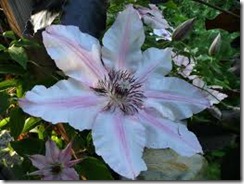The Ascochyta clematidina fungus causes clematis wilt, in which a plant suffers a dramatic stem collapse accompanied by blackening of the affected stem and its leaves. Many plants survive, however. Follow a few simple steps to help your Clematis recover.
Cutting Back
-
Immediately remove any wilted stems, cutting back to healthy tissue. If the disease affects the entire plant, cut back to the soil level. The University of Rhode Island Cooperative Extension advises cutting below the soil line, if necessary, to remove all wilted growth.
Interim Care
-
Continue to treat your affected clematis as an actively growing plant. Wilt does not damage roots, so the plant may send up new shoots and even bloom the same season wilt strikes. Clematis need evenly moist soil and thrive with monthly fertilizing during the growing season, states Washington State University Extension.
Cleanup
-
Wilt usually affects actively growing clematis, but be sure to remove all fallen clematis leaves and other plant detritus during your fall garden cleanup. This will reduce the likelihood of reinfection by the fungus the following spring, according to the University of Nebraska-Lincoln Extension.
Prevention/Solution
-
Large-flowering clematis species are more susceptible to wilt. If wilt is a problem, Washington State University Extension recommends planting smaller flowering species, such as C. alpina, C. macropetala, C. montana and C. viticella.


Deprecated: strpos(): Passing null to parameter #1 ($haystack) of type string is deprecated in /home/agriviek8Qv/agriviet.net/public_html/wp-includes/comment-template.php on line 2522